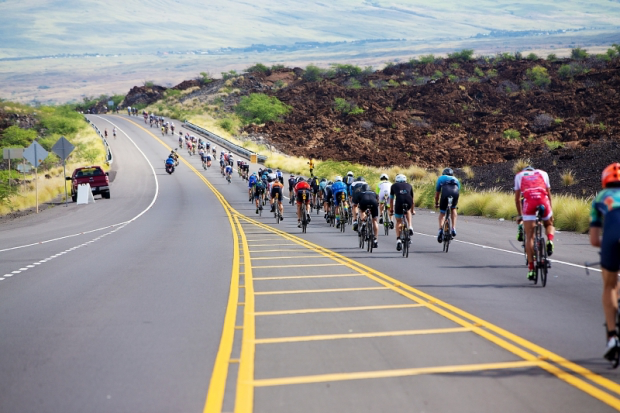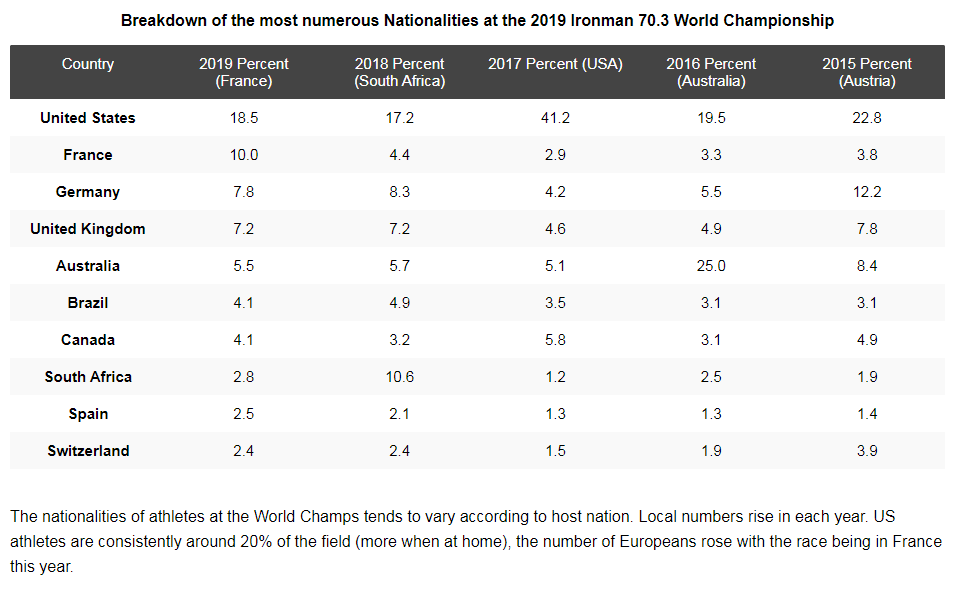Definitely true. The 70.3 Worlds women’s field was much smaller than the mens (racking in T1 went to about row 50, with c100 needed for the men), and that was with all the bonus WFT slots they were offering at 70.3 races.
Ironman is basically an athletic version of Golf. Full of middle-aged white men.
My opiinon which may not be a solution is that Kona should move around the championship courses, ie Frankfurt, Aus, Brazil, S.A., Asia etc with the final N.A. version being back in Kona. Would mean a 6 year cycle. maybe Aus/NZ/Asia could be mixed all as one. Then to qualify you must do a true qualification race, a continental champ, and keep numbers low. Kona would then in between be a normal race (or N.A. continental champs) allowing anybody the chance to race the course if going to Kona is really a thing. I would then make numerous races basically “sportives” for the one and dones. The rest would be proper races with applications and acceptance based on some sort of criteria, ie sub 6hr 70.3 but with no world QF slots up for grabs. Those races would be used to help select athletes into the QF events, ie no 17hr or one and dones allowed!
Good point, no chance could break even financially from women’s race, only 15% of competitors are female.
I wouldn’t agree with that at all. Go to SE Asia and it’s a completely different scene.
I think going to Kona is such a ‘thing’ that you would get a huge spike in qualification interest in the year it’s held there, and a drop off in the other years. That would diminish over time as the number of people attached to Kona gets diluted.
I don’t know the figures for the 70.3 Worlds, but I assume travel costs dictate the field is heavily skewed towards the continent that is hosting? At least Kona is expensive for everybody. Not saying I’m against the idea, but I think it would be a brave person who takes the WC away from Kona.
Kind of, although I think it’s also just reflective of the nations where tri is “big”, and have the most number of qualification races nearby…
“The United States of America is the most represented nation with 1,053 registered athletes, followed by France (568), Germany (444), United Kingdom (416) and Australia (314).”
Originally from: https://eu.ironman.com/triathlon/news/articles/2019/09/facts-and-figures-from-nice.aspx#ixzz60Ritnk6x
Interesting, I guess when each event has equal qualifying slots it can’t skew the demographic that much - not everyone is going to travel to Dubai ![]()
They do increase slots in some events as a special don’t they? Presumably done to increase the number of locals qualifying. Comparing to the allocation for South Africa would be interesting,
Sorry, I should have said middle aged affluent white men ![]()
I have no idea what the Asian Tri scene is like tbh.
I assume there are more qualifying events (i.e. slots) in NA than anywhere else looking at those stats. Although it could be argued that the US is the size of Western Europe I guess.
They have a bucket load of races over there, so you would presume so.
There’s a table I just found on a coach cox post (2019 Ironman 70.3 World Championship: Age Group Results Analysis | CoachCox)
He pretty much supports the working theory … and you can clearly see spikes in the French numbers this year, SA numbers last year, and the US numbers the year before, and the Aus numbers the year before that. Although it would seem that outside of the host country, most other numbers (even other European countries) are broadly fairly static.
But how do the host nation ‘bag’ all the extra slots…unless they increase the qualification slots for them? I can’t see all the Aussies & Americans travelling abroad to get slots the year before, or do they?
Maybe ex-pats taking slots further afield on roll down, who know they can “travel” but build it into one of the trips home they’d otherwise make? I know for example that a couple of Kiwi’s in my London club are thinking of Taupo next year as a dual trip to race, and see family.
I know in France this year, they introduced a new 70.3 (Sables d’Olonne) that had 75 slots for Nice, yet next year it’s only got 40 for Taupo. Whether that’s a reflection of host nation perks, or the fact it was the first running of the race and to entice some entries, I’m not sure.
That is massively skewed towards Australia!
Oz pop 25MM
UK pop 67MM
Germany pop 83MM
US pop 329MM
This has given me a great idea for something to do 

This image is called “Largest AG Pack 2” as its JPG URL over on ST

Where is that @Poet? It looks so egregious!
Looks like cheating to me…
But with those numbers … hard not too
The old ‘Kona drafting’ pic. The new wave starts should reduce this; no doubt some ‘cheats’ but also it proved that it was impossible not to draft due to the density of athletes.
See below:
We had ca. 350 athletes exiting the swim within 5 min with the swim time 60-65min. In order to ride legal 12 metres apart (front to front or 6 bike lengths or 10m + a bike) they would need over 4.2km of the road to spread into one long legal line. Travelling at 36kmph 4.2km takes over 7 minutes but they have exited the swim within 5min so already 40% of this group don’t have the time/space to ride legally. Also people swimming between 55 and 60min and 65-70 don’t have enough space as they need more than 5 minutes to cover distance required to ride legally. If people go slower they will need more time so riding slower actually makes the situation even worse.
What about overtaking? Faster athletes may attempt to continuously overtake those traveling at 36k. In order to overtake 4.2km line of athletes riding at 36kmph in one hour the overtaking athlete needs to go 4.2kmph faster – over 40kmph and it would take them 40km to get to the front, not many Pros average 40kmph and over 40k they would be riding parallel to someone else. More realistically a faster cyclist going at 38kmph (also not many of those) would need 2 hours or 76km to overtake such a line! If people were riding side by side 4.2 line becomes two 2.1k lines but is it realistic for 350 people ride at slightly different speed orderly side by side?
I think that Nice demonstrated that even with 3500 people on the course, a wave start can spread the field very effectively, however, it means that some people start 2.5 hours after the first ones, which can make a big difference in terms of competing during the hottest part of the day
The thing was, that was a combination of wave starts, and the benefit that the rolling start also provides. I’d argue the latter has the bigger impact. And it helped they separated the key AGs between the start, middle and end of the rolling start.
It won’t make much difference at Kona. It’s still a mass start within the waves, and all the men are going to be off between 6.55 and 7.10. That’s not enough of a gap to make a meaningful difference. I imagine it will be a bit better, but I’m not sure it’ll be a magic bullet. As TRO has shown with his quote, the issue is the high volume of athletes on the course all racing at roughly similar speeds. 5min gaps now mean that instead of 350 men coming out together who all swam 60-65, you probably just get 350 men but some of whom swam 65-70 in wave 1, some who swam 60-65 in wave 2, and some who swam 55-60 in wave 3.
